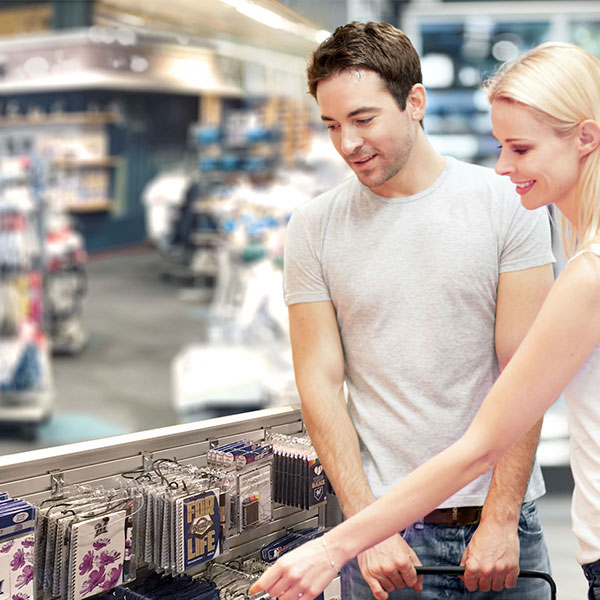
Queue & A: 5 Tips to Boost Profits Using Store Fixtures
Are Your Store Fixtures Boosting Profits? Tips From a Retail Queuing Expert
From bustling big box stores to speedy convenience stores, the checkout queue offers simple ways to improve store operations while boosting profits.
Perry Kuklin, a queuing expert from Lavi Industries, delves into the art and science of retail queue design, sharing strategies to transform waiting lines into valuable assets.
Queue Evolution: From Bane to Boom
In the early days, storefront fixtures were everything—and queues were an afterthought. "There was no such thing as a merchandised queue," Perry explains. "It took years for U.S. retailers to grasp the potential of selling to people waiting in line." As retail environments grew larger and more complex, so did the need for more structured queuing systems and specialized retail queuing products like slatwall gondolas. Today’s checkout queues are more than just lines—thoughtful designs make waiting easier and more enjoyable for customers, streamlining operations for staff and ultimately boosting revenue for retailers.
5 Tips For Optimal Retail Queue Design
When designing a queue, many retailers focus solely on the physical flow, and fail to consider the customer experience. Two common pitfalls—poor signage and neglecting merchandising opportunities—often arise from failing to take a 360-degree view of how customers interact with a queue and its surroundings.
When it comes to maximizing product visibility and accessibility without compromising flow, Perry guides clients through five strategic considerations:
1. Understand customer flow.

Before diving into design, get a clear understanding of how customers move through your space. While data analytics tools can help analyze traffic patterns and wait times, keen insights can also come from simple observation and customer feedback.
Key questions to ask:
- How many people typically use your queues?
- When are your peak service hours?
- How does customer flow vary between busy and slow times?
- When is the peak of customer arrival and when are arrivals at their lowest?
- What are the service points, and how long does service take on average?
- What are the architectural constraints? Are there architectural drawings?
- Are there multiple types of service (standard vs. self-checkout), and are they segmented by separate service points?
Most clients come to Lavi with one or two specific problems they’re trying to solve—the most common being how to efficiently manage overcrowded periods.
2. Plan for surges and flexibility.

"Prepare for overflow by planning where the line will naturally extend," Perry recommends. “To manage crowds effectively, avoid blocking key areas like store entrances, and consider using additional stanchions or portable gondolas that easily roll out and extend the queue.”
Choosing modular queue components—like gondola shelving—lets retailers create countless planograms, test their products, and learn. Perry uses design software to mock up what a queue might look like and may request a site visit if the needs are complex. But even the best-laid plan may require an update. After installation, his team provides ongoing support, adjusting and improving—updating signage, modifying belt configurations, or adding new sections as needed.
3. Provide highly visible direction.

"The biggest mistake retailers make with their queue design is a lack of communication and signage," Perry emphasizes. Clear, visible signs are essential to guide customers to the right place. "An efficient queue starts before a person even gets in line. What lane should they be getting into for their particular need?” Sometimes the solution is as simple as placing overhead banners that say “checkout” and “self-checkout.”
4. Monetize wait time.

Retailers often overlook the merchandising potential of their queues. "Queues create a captive audience,” Perry suggests. “Use this time to guide customers toward strategically placed merchandise on a slatwall retail display designed for unplanned purchases."
Structure your queue to make it easy for customers to see and access these opportunities, using ??36-inch-tall retail slatwalls or gondola fixtures that are easy to browse up close or from a distance. Then, go beyond the standard slatwall display panels by incorporating advertising and branding into the queue design.
"One effective strategy," Perry adds, "is to merchandise the outside perimeter of the queue—viewed by everyone in the store, not just those in line."
5. Incorporate technology.

“Electronic queuing is a natural fit with physical lines, enhancing efficiency and encouraging impulse buying through digital signage,” says Perry.
A wireless electronic queuing system organizes customer flow and improves communications to help retail stores run smoothly. Remote controls manage displays, alerts, and announcements, while flashing signals and pole lights at each checkout station direct customers to available registers, speeding up service.
Between queuing prompts, large screen HD digital displays can play safety instructions or promotional ads. Perry adds, "There's a great synergy between showcasing products on retail store fixtures and also featuring them on the electronic queuing monitors."
By incorporating video advertising directly into the queue, retailers capture customer attention, turning waiting time into an opportunity for engagement and driving last-minute purchases.
As Perry puts it: “Retail queues are evolving from a simple necessity into a powerful marketing tool.”
Check out this interactive map to visualize how all different components like retail shelving, slatwall fixtures, and store gondolas come together in a retail environment. If you’d like further assistance designing flexible and revenue-generating retail queues, talk to the experts at Lavi.
SUBSCRIBE
Subscribe to stay up-to-date with new products, resources information and news.
RECENT RESOURCES
Theft at the Register: How Strategic Queue Design Protects Profits
ViewRapid Deployment Crowd Control: JetTrac Portable Barriers For The Biggest Spaces
View4 Psychological Reasons Your Customers Hate Waiting In Line
ViewFrom Bleachers To Bookstores: 4 Campus Crowd Control Solutions
View








